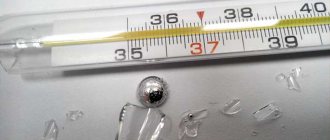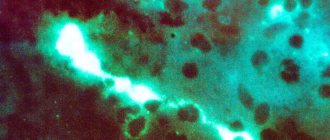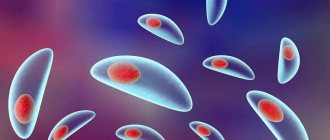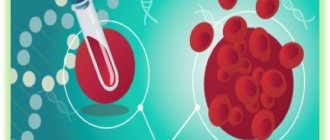Hemoglobin is a special blood protein found in red blood cells. Performs a vital function. Thanks to it, cells and tissues are saturated with oxygen, and gases and substances are exchanged in the body. Therefore, the importance of hemoglobin cannot be overestimated. If its level drops, health problems occur. This could be due to various reasons. So it is necessary to maintain a normal protein level and know ways to restore it.
Low hemoglobin - why it is dangerous
Hemoglobin is a complex chemical component of blood, which consists of protein and iron molecules. This constituent component is part of red blood cells and circulates through the bloodstream of the human body. The main task of hemoglobin is to transport oxygen molecules from the lungs to tissues, cells and internal organs.
With low hemoglobin, oxygen saturation of the body's cells decreases, which causes a decrease in immunity, a person loses vitality, organs do not receive proper nutrition, as a result of which their functionality is significantly reduced. Tissue cells suffer from oxygen depletion.
The most important complication of low hemoglobin is iron deficiency anemia. Its severe forms can cause loss of consciousness due to a high degree of brain hypoxia.
Prevention of anemia
To prevent the development of anemia, it is necessary:
- avoid contact with poisons and toxic substances;
- refuse to visit areas contaminated with radiation;
- do not contact with sources of ionizing radiation;
- do not take medications uncontrollably;
- to harden;
- eat right, include meat, greens, fruits and vegetables in your daily diet;
- spend more time outdoors.
Secondary prevention of low hemoglobin includes:
- blood test once a year;
- seeking qualified medical help in the event of acute infectious and viral diseases;
- annual medical examinations;
- pregnancy planning (for women).
This article is posted for educational purposes only and does not constitute scientific material or professional medical advice.
Low hemoglobin symptoms
Hemoglobin levels can be easily measured using a laboratory blood test, which can be prescribed by the local physician observing the patient. If you suspect a decrease in hemoglobin, and there is no time to wait for an appointment at a city clinic, you can contact any private laboratory. Such institutions often offer discounts on comprehensive examinations. You can donate blood to such an institution any day. The laboratory will not require you to buy your own syringe and container.
Symptoms to suspect low hemoglobin levels:
- daily weakness that does not disappear even on rest days;
- pale skin;
- there is a decrease in memory;
- tremor of the limbs appeared;
- hair lost its shine and began to fall out;
- shortness of breath appeared;
- Heart rate increased even at rest.
At the first signs of a decrease in hemoglobin, you should consult a doctor or donate blood yourself to check the iron level in your blood. However, detecting a decrease in hemoglobin is not enough. It is important to determine the reason why the body lacks it.
What is the norm for hemoglobin
As is already known, the protein is found in red blood cells and is responsible for the transport of oxygen in the body.
To maintain a normal level of health, eliminate fatigue, malaise and other characteristic signs of low hemoglobin, it is recommended to regularly take a blood test to determine protein.
The hemoglobin level is different for everyone, depending on age, gender and physiological characteristics of the body. So, for men this figure is 125-160 g/l, for women 115-140 g/l. In newborn babies, the protein level is in the range of 140-195 g/l; for children one year of age, hemoglobin is 110 g/l. And at school age, the blood protein level is at least 150 g/l.
In women, during pregnancy, hemoglobin drops and this is considered normal. At this time its value is about 110 g/l.
As a rule, a low rate is associated with iron deficiency anemia, which occurs in most people, regardless of age and gender.
Reasons for decreased hemoglobin
Hemoglobin appears in the blood thanks to a balanced diet rich in iron. First of all, the attending physician must find out which diet predominates in the patient. If the patient eats meals that exclude meat, animal proteins and legumes, the first step is to restore a varied diet.
If the patient is eating a fairly healthy and nutrient-dense diet but still has low hemoglobin, a number of other tests should be performed.
If we are talking about a female patient of reproductive age, then first of all it is necessary to conduct an ultrasound examination of the pelvic organs to detect pathologies that cause heavy bleeding. In addition, it is important to understand how much a woman experiences monthly blood loss associated with the menstrual cycle. Often they become the physiological cause of decreases in hemoglobin. In this case, the gynecologist should suspect the presence of fibroids, which forces the walls of the uterus to contract intensively, causing increased blood loss.
If we are talking about a male patient or examination of the female reproductive system did not produce results, the next stage of examination should be gastroscopy and colonoscopy. These diagnostic methods will help identify internal bleeding that is not so heavy as to become noticeable, but its regularity causes a significant amount of blood lost.
The third, no less important reason why hemoglobin may decrease is leukemia. This disease is associated with a gene mutation and causes disturbances in the functioning of the hematopoietic system.
Why is hemoglobin low?
There is no clear reason. It is impossible to talk about the development of pathology every time the hemoglobin level is below normal. This may be a temporary phenomenon caused by trauma with blood loss, surgery, donation, vegetarian diet, and in women, additionally, the menstrual cycle.
The basis for the development of the disease may be pathological processes occurring in the body:
- digestive problems (colitis, enterocolitis, dysbacteriosis);
- bleeding;
- failure of the immune system;
- infection of the body;
- leukemia, lymphoma;
- uterine fibroids, causing bleeding;
- disease of the hematopoietic system;
- tumors of various origins;
- kidney pathology.
It is important to know! During pregnancy, the hemoglobin level is 30 to 20 units below normal. But this is a temporary phenomenon that goes away after the birth of the child, in the absence of chronic diseases.
Can there be too much iron in the body?
Maybe. An excess of iron is just as harmful to the body as its deficiency. It causes fibrosis of organs and tissues. The pancreas, liver and heart are most often affected. However, it is impossible to achieve an excess of iron through diet alone. The pathology is often due to genetic predisposition and improper or uncontrolled use of iron-containing drugs.
What is an increase in hemoglobin called?
An increase in the number of red blood cells and an increase in hemoglobin is called erythrocytosis. Its characteristic symptoms: nosebleeds, headaches and dizziness, fatigue. Erythrocytosis, in turn, can be a sign of various diseases, which only a doctor can determine.
What does it mean if hemoglobin is elevated?
High hemoglobin levels can be caused by dehydration, smoking, lung cancer, heart disease and other pathologies. Elevated hemoglobin sometimes indicates the presence of a rare disease - polycythemia. When this happens, the body produces too many red blood cells, which can lead to blood clots, heart attacks and strokes. This is a very serious disease that is important to identify and control early throughout your life.
What are the consequences if low hemoglobin is not treated?
Oxygen delivered by hemoglobin ensures the normal functioning of all organs. If it is not enough, then functional and organic changes begin, resulting in a life-threatening condition. The degree of damage depends on the duration of oxygen starvation, and the consequences lead to the formation of a number of pathologies:
- painful changes in the liver;
- development of shortness of breath;
- the appearance of pathological changes in the vascular and cardiac systems;
- disruptions in the functioning of the nervous structure;
- changes in the composition of the blood, a decrease in red blood cells - anemia;
- development of atherosclerosis;
- exacerbation of chronic diseases.
A slight decrease in hemoglobin relative to the norm is associated with weakness and increased fatigue. As the gap in indicators increases, a depressive state and irritability appear.
Note! A large lack of hemoglobin in pregnant women is fraught with premature birth and the development of hypoxia in the unborn child.
How to increase hemoglobin in the blood of women?
What to do? First you need to determine the cause of its decrease, then treat it. If it is iron deficiency anemia and the hemoglobin level is above 100 g/l, it can mostly be treated with an iron-containing diet. If very low hemoglobin is detected in a woman, treatment should be prescribed by a hematologist.
Seeking qualified help
If you suffer from increased fatigue, lethargy, decreased performance, deterioration of intellectual capabilities, dizziness, shortness of breath, palpitations, you should suspect the presence of anemia. In this case, you should contact a specialist and undergo the necessary tests.
What is the hemoglobin test called?
A general clinical blood test, which must be taken annually, and for pregnant women every trimester, will help determine a decrease in hemoglobin levels. This test can determine the level of red blood cells (RBC) and hemoglobin (Hb), white blood cells (WBC) and leukocyte formula, as well as the erythrocyte sedimentation rate. Some laboratories immediately determine the color indicator (the amount of hemoglobin in each red blood cell); if this is not the case, your doctor can determine this. This indicator helps the doctor in determining the type of anemia.
Sometimes it is necessary to take a biochemical blood test for serum iron, transferrin, ferritin, cyanocobalamin (vitamin B12), folic acid (vitamin B9), and determine the level of direct and indirect bilirubin. These tests will help the doctor make a differential diagnosis and determine the type of anemia.
Which doctor should I contact if I have low hemoglobin?
If symptoms of anemia appear, you should contact your family physician. The doctor will collect an anamnesis of the disease and conduct an examination to determine a preliminary diagnosis, because the general symptoms of anemia are characteristic of many other diseases. The doctor will write you a referral for a general clinical and, if necessary, biochemical blood test.
In cases of mild to moderate anemia, treatment is prescribed by your family doctor. And if symptoms appear suddenly within a few days, or severe anemia, then treatment is prescribed by a hematologist in an inpatient setting. In some cases, drug therapy may be needed. In any case, the doctor must decide how to increase hemoglobin.
Drugs to increase hemoglobin
In order to increase hemoglobin, you first need to cure the cause of its decrease. If a woman has a deficiency of iron or vitamins, it needs to be replenished; if anemia occurs as a result of chronic bleeding, the cause of the bleeding must be treated along with correcting the hemoglobin level.
Iron supplements for low hemoglobin
It would seem that the body does not have enough of a microelement - which means you need to use more food containing it or medications. But what plays a role here is not just what a woman eats when her hemoglobin is low, or what medications are used to increase it. Iron can undergo chemical reactions in the stomach or intestines. These reactions can increase its absorption or prevent it. Therefore, we have outlined for you the basic rules for taking iron supplements.
- The daily iron requirement for women of reproductive age is 15 mg. The average amount of iron taken with food is 50-100 mg, of which only 10-25 mg (20-25%) is normally absorbed. If you take iron medications, the level of its absorption will be the same: per 100 mg, only 20 mg will be absorbed. But you should not increase the prescribed dosage to speed up recovery from anemia. Iron that is not absorbed (80 mg of the 100 mg taken) can irritate the intestinal mucosa. And if you increase the dose, it will be worse absorbed, more irritate the mucous membrane of the digestive tract, cause constipation and abdominal pain.
- Mild iron deficiency anemia in non-pregnant women is most often corrected with diet. A small deficiency can be compensated for by eating a large amount of foods that contain iron. In this case, drug therapy will cause more harm, irritate the intestines and will not lead to rapid restoration of hemoglobin.
- If hemoglobin decreases below 70 g/l, treatment takes place in a hospital setting with intravenous administration of drugs. The dose is prescribed individually, iron deficiency is replenished quickly enough.
- The duration of treatment with tablets is 4-8 weeks to increase hemoglobin by 20 g/l. If the dynamics are weaker, you should consult a doctor to prescribe intravenous administration of iron-containing medications.
- To increase iron absorption, it is also worth increasing the level of vitamin C, B12 and folic acid.
- When taking iron supplements, it is important to take it with water or orange juice (vitamin C) for better absorption. Do not drink milk, tea or coffee - they impair the absorption of iron.
- Iron is a chemical element that can have different valencies. Bivalent iron preparations have a better degree of absorption than trivalent iron. But the choice is always up to your attending physician: he prescribes the drug taking into account your hemoglobin level, age, cause of anemia and the presence of concomitant diseases.
There are many iron preparations on the pharmaceutical market, which differ in valency (divalent or trivalent) and type of salt (organic or inorganic).
Ferrous iron is better absorbed in the intestines, so it is often used to treat iron deficiency anemia. The main drugs: totema (iron gluconate), ferretab (iron fumarate) - representatives of organic salts; sorbifer, actiferrin, tardiferon, ferro-gradumet (iron sulfate), hemofer (iron chloride) - inorganic salts.
Advantages of ferric iron preparations: high digestibility, treatment duration is shorter than with ferric iron.
Disadvantage: higher incidence of side effects.
The best ferrous iron preparations
- Actiferrin is ferrous sulfate produced in Germany. Available in the form of capsules, drops, syrup - choose the one that is convenient for you. It has a pleasant currant taste. The composition includes the amino acid L-serine, which increases the absorption of iron. With a combined deficiency of iron, vitamin B12, and folic acid, it is possible to use the combined drug Aktiferrin compositum, which contains all these substances in one capsule.
- Totema is an iron gluconate produced in France. Available in the form of a solution in ampoules for oral administration. The ampoule can be poured into apple or orange juice for better absorption and taste. Contains manganese and copper - they increase the bioavailability of iron.
When treated with ferric iron preparations, the risk of developing side effects such as bloating, a feeling of heaviness in the abdomen, nausea, and constipation is reduced. Main preparations: ferlatum (iron succinylate) – organic salt; ferrum-lek, maltofer, biofer – inorganic salt of iron hydroxide with polymaltose.
Advantages: less frequency and severity of side effects, available in injection ampoules for the treatment of severe anemia.
Disadvantages: the degree of digestibility is lower than that of divalent ones, long-term treatment.
How to make iron better absorbed
To increase hemoglobin, it is not enough to simply include iron-containing foods in your diet. It is important that the nutrients are absorbed as much as possible and are beneficial. To do this, you should know which products can and cannot be combined with each other.
Iron is best absorbed in the presence of vitamins C and A. That's why seafood with lemon is not only tasty, but also incredibly healthy. A few drops of lemon can be added to salads and other dishes. Almost all fresh vegetables and fruits, such as bell peppers, are rich in vitamin C. Vitamin A is found in fish, oil, vegetables and orange fruits.
It is important to ensure that the body receives folic acid, which takes part in the synthesis of red blood cells. Therefore, you should regularly eat beef, green salad, avocados, legumes, rice, peanuts and other foods high in folic acid.
But calcium and casein (milk protein) reduce the absorption of iron, so you should not consume dairy and fermented milk products and cheeses along with vegetable and meat dishes. Wheat and other grains have a negative effect on the absorption of iron. So it’s better to eat meat without bread, and use vegetables rather than pasta as a side dish. Among the foods that can provoke hemoglobin deficiency: tea, coffee and persimmons (contain tannins), bread, soy, canned food, soda, processed cheese. Therefore, you should not abuse them.
Hemoglobin level in women during menstruation
During the menstrual period, protein content decreases sharply. This feature of the female body is associated with loss of blood fluid and is not a sign of pathology. It is for this reason that women feel unstable during menstruation:
- dizziness occurs (about other causes of dizziness here);
- appetite increases;
- there is a persistent feeling of fatigue, etc.
At the same time, experts recommend refraining from taking blood tests a few days before/after menstruation, as the information will be distorted. The normal level of hemoglobin after menstruation is restored within 2 – 3 days (with correct nutrition and lifestyle).
Frequently asked questions and doctor's answer
General practitioner Victoria Druzhikina answered questions
1. What is Hemoglobin indicated in a blood test?
- “In a general blood test, hemoglobin is abbreviated as Hb, measured in grams per liter.” 2. Why is low Hemoglobin dangerous?
– “Low hemoglobin levels are dangerous due to anemia and its consequences:
- oxygen starvation of organs and tissues, primarily nervous;
- muscle weakness;
- fainting due to decreased blood pressure;
- decreased immunity;
- wear and tear of the heart muscle due to the development of compensatory tachycardia in conditions of lack of oxygen;
- heart attacks;
- retardation in mental and physical development.
In severe cases, untreated anemia can lead to hypoxic coma and death due to brain or heart failure.”
3. Blood transfusion for low hemoglobin
– “To treat severe forms of anemia, blood or red blood cell transfusions are used. The procedure is indicated in 2 cases:
1. With a hemoglobin level of 70 g/l and below.
2. In case of poor tolerance to anemia and the threat of hypoxic coma at any level of hemoglobin. This can occur in people whose lives involve high oxygen consumption - pregnant women, athletes, scuba divers playing wind instruments.
The standard regimen is 2 doses (1 dose – 200 ml) twice a week. Before and after the procedure, general urine and blood tests and temperature must be monitored.
Before the manipulation, the patient’s blood type and Rh factor are determined, and donor blood is selected based on these indicators. Next, the compatibility of the blood samples is checked. If the reaction proceeds normally, a transfusion is performed. If flakes or clots form, this blood is not transfused, but other samples are tested for compatibility.” 4. Hemoglobin norm in children under one year old
– “The hemoglobin norm in children under one year of age is determined by physiological factors. By the end of the 1st month, the numbers are higher than in adults and amount to 160–200 g/l.”
5. How to increase Hemoglobin in a child?
“If anemia is detected, it is important to increase hemoglobin levels as soon as possible, especially in children. The main role in this belongs to drugs. Unfortunately, nutrition will not significantly increase the numbers. With the help of food, you can only slightly improve your performance and maintain it at this level.
Foods to increase hemoglobin in children:
- beef;
- buckwheat;
- cocoa;
- liver;
- apples;
- pomegranate;
- walnuts.
Drugs for the treatment of anemia in children:
- Maltofer;
- Ferrum Lek;
- Totema;
- Ferlatum and others"
6. How to increase hemoglobin during pregnancy?
“During pregnancy, it can be difficult for a woman to follow a diet with foods rich in iron. However, their list is quite wide, you can choose what you like:
- beef;
- wheat bran;
- hazelnuts;
- cabbage, including broccoli;
- chocolate;
- rabbit;
- liver;
- cocoa;
- apples;
- pears;
- parmesan, etc.
How to increase hemoglobin during pregnancy - the most used drugs:
- Maltofer;
- Sorbifer Durules;
- Ferrum Lek;
- Gyno-tardiferon;
- Totema;
- Ferlatum and others."
7. Iron supplements to increase hemoglobin in adults
– “To treat anemia in adults, the same drugs are used as for pregnant women. Can also be used:
- Venofer;
- Ferlatum protein;
- Cosmopher;
- vitamin complexes with iron (Ferro-Folgamma, Fenyuls, etc.).”
8. Normal Hemoglobin in Newborns? – “The hemoglobin norm varies slightly from month to month, the generally accepted average values are 120–160 g/l.
Immediately after birth, the mother’s blood circulates in the baby, so values from 180 to 240 g/l are considered normal for the 1st week of life.”
For information on hemoglobin levels, see also the video:
This article has been verified by a current qualified physician, Victoria Druzhikina, and can be considered a reliable source of information for site users.
Bibliography
1. The norms of indicators are indicated in Appendix No. 3 of Order of the Ministry of Health of the Russian Federation dated 09/14/2001 364 (as amended on 06/06/2008)
Rate how useful article
4.7 was. 30 people voted, average rating 4.7
Did you like the article? Save it to your wall so you don’t lose it!
What is anemia and how to diagnose it
Anemia (or anemia) is a decrease in hemoglobin and a decrease in the number of red blood cells in the blood. This condition leads to the fact that organs and tissues do not receive the required amount of oxygen, metabolic processes and the general well-being of a person worsen. The first symptoms may be fatigue, shortness of breath, loss of appetite, dry skin, brittle hair and nails and other signs that are not always immediately linked into a single picture.
This is why it is extremely difficult to diagnose anemia on your own, and it is impossible to do this based only on laboratory test results. To make a diagnosis, doctors not only look at the level of hemoglobin and iron, but also check the level of cholesterol, glucose, creatinine, uric acid and electrolytes, assess the general condition of the patient and his internal organs, and conduct a comprehensive diagnosis.
Severity of anemia:
- Mild anemia:
the level of hemoglobin in the blood is less than normal, but more than 100 g/l. The symptoms are subtle, so a person rarely turns to specialists at this stage of the disease. - Moderate anemia:
hemoglobin level in the blood is from 66 to 100 g/l. Frequent dizziness, nausea, drowsiness appear, dryness and cracks in the skin become noticeable. - Severe anemia:
hemoglobin level in the blood is less than 66 g/l. Critical condition, clouding and loss of consciousness, cold hands, fainting. Emergency hospitalization is required as there is a serious threat to life.
However, it is worth consulting at least with a therapist when the indicator drops below 120 g/l in women and below 135 g/l in men, without waiting for the condition to worsen.
How dangerous is anemia for humans?
This disease can be considered both dangerous and relatively harmless at the same time. On the one hand, mild anemia occurs quite often and can be treated without problems. On the other hand, long-term iron deficiency and low hemoglobin levels place a serious burden on the body. Severe anemia can have serious consequences:
- malfunctions of the kidneys, liver and other internal organs;
- diseases of the cardiovascular system;
- cognitive impairment;
- increased risk of falls and, as a result, injuries and fractures;
- oxygen starvation (hypoxia), risk of myocardial infarction and stroke;
- exacerbation of chronic diseases;
- deterioration of the reproductive system;
- anemic coma or death.
However, there is no need to panic. Pathologies and complications tend to develop if hemoglobin is greatly reduced for several years. Regular monitoring and testing of tests 1-2 times a year will be sufficient prevention and will help to quickly identify the problem and begin treatment.
It is important for pregnant women and young children to monitor the level of hemoglobin in the blood and prevent it from decreasing. Otherwise, there is a risk of pregnancy complications, premature birth and impaired fetal development - a malfunction of the brain, nervous and respiratory systems. In young children, a lack of hemoglobin can cause delayed intellectual development.
When to donate blood for hemoglobin
The reason to consult a physician or hematologist and take a blood test for hemoglobin level may be the detection of the above symptoms - one or more, a serious deterioration in health after an illness, significant blood loss due to injury or during surgery, adherence to a strict diet, an identified disease blood from close relatives, pregnancy.
A slight decrease may not be noticeable to humans. To prevent changes in hemoglobin levels from becoming a surprise, it is better to keep the situation under control: get your blood tested 1-2 times a year, and if necessary, consult a hematologist.
How to maintain normal hemoglobin levels
For a healthy person without congenital pathologies, it is important to monitor the daily routine, drink enough water, eat a balanced diet, include foods rich in iron and vitamins in the diet, lead an active lifestyle and periodically undergo general and biochemical blood tests.
These tips may seem obvious and even banal to you, but they will help prevent a decrease in hemoglobin, the development of anemia and other diseases, and improve your well-being and quality of life.
This material summarizes the best research on evidence-based medicine over the years. However, it is for informational purposes only, is not intended to prescribe treatment, and cannot be used as a direct guide to action.









